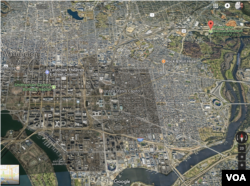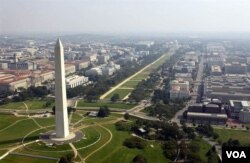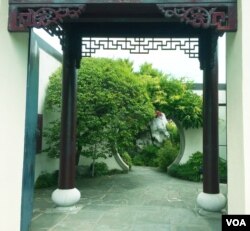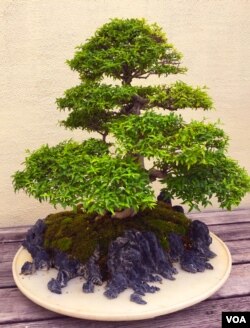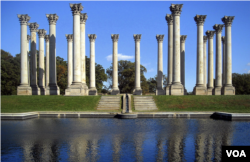Student Union
You Asked Monika, She Went to the U.S. National Arboretum

Our first quest came from Mohamed Hussein.
"Please, I like to see U.S. National Arboretum."
First, I had to find it.
The arboretum is not part of the downtown Washington Mall area where 14 museums and institutions line the grassy and treed area that stretches from the Washington Monument (an obelisk) to the U.S Capitol. That's what you normally see on postcards.
The National Arboretum is more than 400 acres of trees, plants, herbs and flowers in the northeast part of the city, along the Anacostia River. It was established in 1927 and it's a living museum where trees, shrubs, and herbaceous plants are cultivated for scientific and educational purposes according to its website.
The arboretum -- "arbor" is a garden structure on which plants and vines can grow -- is divided into 10 themed gardens and collections such as Asian Collection, National Herb Garden, National Bonsai & Penjing Museum and others. It’s like taking a walk in a really big and well organized park, but with research labs.
Thanks to Google maps you can actually take a virtual stroll through the Arboretum.
We arrived in the morning and headed to the information center and asked for the four best things to see. The lady at the desk took our map and with a steady hand circled National Bonsai & Penjing Museum, National Herb Garden, National Capitol Columns and Asian Collection.
We started in the National Bonsai & Penjing Museum. The difference between bonsai and penjing (or penzai) is that bonsai is the Japanese style of growing ornament trees and penjing is its Chinese precursor. Bonsai is the Japanese way of pronouncing penzai and thus the origin of the word. This artistic way of growing trees dates thousands of years back. For the grower it is an exercise of patience, consistency and ingenuity, and for the viewer it's a pure pleasure of looking at little ornamental trees. The miniature bonsai can be as small as 8 cm and the large can be as "big" as 200 cm, depends on the type. The age of the trees also depends on their type, but due to their need for delicate care, they can be killed fairly quickly. The collection in the National Arboretum is divided into three Pavilions (Japanese, Chinese, North American) and was started in 1976 by donation of 53 bonsai to the people of the United States.
When you're approaching the Herb Garden the smell of herbs just hits you (what a surprise). The Herb Garden began in 1980 as a gift to the people of the United States by the Herb Society of America. To this day, it is the largest design herb garden in the country. It contains over 800 kinds of herbs. Every plant in this garden is an herb, including trees.
However as you walk through you realize that you have no idea how each herb looks like, even the ones you normally use in kitchen, which makes you feel really smart. With that in mind I started looking for chili peppers. I was positive I would recognize at least those, but I did not find them. Not many people realize trees are also considered herbs as many of them are used as medicine and spices.
The perfect example would be Elder, Ginkgo, Lemon Tea Tree and Coffee plant. The coffee plant is considered herb because it's not used only to make our favorite coffee drink, but is also used as medicine. I ended up having a little love moment with the coffee plant as coffee is my daily live support and we headed over to the National Capitol Columns.
The cool thing about the Columns is that they have nothing to do with flora, yet they are the most photographed attraction in the National Arboretum. Nevertheless they are very majestic as they used to be part of the U.S. Capitol. The columns were built years before the dome of the U.S. Capitol. The dome ended up being bigger than planned and didn't match the columns. That is why they were replaced in 1958. The U.S. government held the original columns in storage until 1984 when the Department of Agriculture decided to display them in the National Arboretum. The steps leading up to the columns also used to be part of the east side of the Capitol.
After the columns the day was growing old and we ran out of time to visit other collections and had to end our visit at the National Arboretum.
The arboretum is a very large area. Even though there are streets connecting all its parts and you can get to different parts quicker, time is still of the essence. We spent over an hour enjoying the calm atmosphere of the National Bonsai & Penjing Museum and about the same time discovering herbs of the National Herb Garden. It is easy to loose track of time if you wonder around such beautiful surroundings, but every minute is worth it.
I want to thank Mohamed for sending me to the U.S. National Arboretum, because it is a truly beautiful place and I wish I could’ve spent the whole day there.
The arboretum is open every day (although I recommend to check their website as there might be exceptions) and the admission is free. It is a perfect place to take an afternoon walk if you want to get away from busy city.
If there’s anything else you want us to see or do, leave a comment and we’ll go right ahead and do it. Next VOA Student U guide is our Liz K!
Please leave a comment here, and visit us on Facebook, Twitter, Instagram and LinkedIn, thanks!
See all News Updates of the Day
- By VOA News
Competition grows for international students eyeing Yale

It’s tough to gain admission to Yale University, and it’s getting even tougher for international students as standout students from around the world set their sights on Yale.
The Yale Dale News, the campus newspaper, takes a look at the situation here.
- By VOA News
Student from Ethiopia says Whitman College culture made it easy to settle in

Ruth Chane, a computer science major from Ethiopia, writes about her experiences settling into student life at Whitman College in the U.S. state of Washington.
"The community at Whitman College made sure I felt welcomed even before I stepped foot on campus," she says.
- By VOA News
Claremont Colleges student gets a shock when she heads home to Shanghai

In The Student Life, the student newspaper for the Claremont Colleges, a consortium of five liberal art colleges and two graduate schools in Claremont, California, student Rochelle Lu writes about readjusting to her Shanghai home after spending a semester in the United States.
- By VOA News
Cedarville University aims to ease transition for international students

Cedarville University in the U.S. state of Ohio says it’s got more than 140 international students representing 44 countries.
Here, the school interviews Jonathan Sutton, director of international student services. He talks about his job and the opportunities for international students on campus.
- By VOA News
Morehouse College offers prospective students tips on applying and thriving

Morehouse College, a private, historically Black liberal arts college in the U.S. state of Georgia, offers a guide for international students interested in attending the school.
Among the tips to apply and thrive at Morehouse:
- Take advantage of the school’s orientation program
- Turn to the school’s Center for Academic Success for tutoring, support and more
- Immerse yourself in campus life via clubs and societies
- By Reuters
US reviews Columbia University contracts, grants over antisemitism allegations

The administration of President Donald Trump said on Monday it will review Columbia University's federal contracts and grants over allegations of antisemitism, which it says the educational institution has shown inaction in tackling.
Rights advocates note rising antisemitism, Islamophobia and anti-Arab bias since U.S. ally Israel's devastating military assault on Gaza began after Palestinian Hamas militants' deadly October 2023 attack.
The Justice Department said a month ago it formed a task force to fight antisemitism. The U.S. Departments of Health and Education and the General Services Administration jointly made the review announcement on Monday.
"The Federal Government's Task Force to Combat Anti-Semitism is considering Stop Work Orders for $51.4 million in contracts between Columbia University and the Federal Government," the joint statement said.
The agencies said no contracting actions had been taken yet.
"The task force will also conduct a comprehensive review of the more than $5 billion in federal grant commitments to Columbia University."
The agencies did not respond to requests for comment on whether there were similar reviews over allegations of Islamophobia and anti-Arab bias.
Columbia had no immediate comment. It previously said it made efforts to tackle antisemitism.
College protests
Trump has signed an executive order to combat antisemitism and pledged to deport non-citizen college students and others who took part in pro-Palestinian protests.
Columbia was at the center of college protests in which demonstrators demanded an end to U.S. support for Israel due to the humanitarian crisis caused by Israel's assault on Gaza. There were allegations of antisemitism and Islamophobia in protests and counter-protests.
During last summer's demonstrations around the country, classes were canceled, some university administrators resigned and student protesters were suspended and arrested.
While the intensity of protests has decreased in recent months, there were some demonstrations last week in New York after the expulsion of two students at Columbia University-affiliated Barnard College and after New York Governor Kathy Hochul ordered the removal of a Palestinian studies job listing at Hunter College.
A third student at Barnard College has since been expelled, this one related to the occupation of the Hamilton Hall building at Columbia last year.
Canada’s immigration overhaul signals global shift in student migration
From Europe to North America, nations are tightening their immigration policies. Now Canada, long seen as one of the world's most welcoming nations, has introduced sweeping changes affecting international students. The reforms highlight a growing global trend toward more restrictive immigration policies. Arzouma Kompaore reports from Calgary.
Trump administration opens antisemitism inquiries at 5 colleges, including Columbia and Berkeley

The Trump administration is opening new investigations into allegations of antisemitism at five U.S. universities including Columbia and the University of California, Berkeley, the Education Department announced Monday.
It's part of President Donald Trump's promise to take a tougher stance against campus antisemitism and deal out harsher penalties than the Biden administration, which settled a flurry of cases with universities in its final weeks. It comes the same day the Justice Department announced a new task force to root out antisemitism on college campuses.
In an order signed last week, Trump called for aggressive action to fight anti-Jewish bias on campuses, including the deportation of foreign students who have participated in pro-Palestinian protests.
Along with Columbia and Berkeley, the department is now investigating the University of Minnesota, Northwestern University and Portland State University. The cases were opened using the department's power to launch its own civil rights reviews, unlike the majority of investigations, which stem from complaints.
Messages seeking comment were left with all five universities.
A statement from the Education Department criticized colleges for tolerating antisemitism after Hamas' Oct. 7, 2023, attack on Israel and a wave of pro-Palestinian protests that followed. It also criticized the Biden administration for negotiating "toothless" resolutions that failed to hold schools accountable.
"Today, the Department is putting universities, colleges, and K-12 schools on notice: this administration will not tolerate continued institutional indifference to the wellbeing of Jewish students on American campuses," said Craig Trainor, the agency's acting assistant secretary for civil rights.
The department didn't provide details about the inquiries or how it decided which schools are being targeted. Presidents of Columbia and Northwestern were among those called to testify on Capitol Hill last year as Republicans sought accountability for allegations of antisemitism. The hearings contributed to the resignation of multiple university presidents, including Columbia's Minouche Shafik.
An October report from House Republicans accused Columbia of failing to punish pro-Palestinian students who took over a campus building, and it called Northwestern's negotiations with student protesters a "stunning capitulation."
House Republicans applauded the new investigations. Representative Tim Walberg, chair of the Education and Workforce Committee, said he was "glad that we finally have an administration who is taking action to protect Jewish students."
Trump's order also calls for a full review of antisemitism complaints filed with the Education Department since Oct. 7, 2023, including pending and resolved cases from the Biden administration. It encourages the Justice Department to take action to enforce civil rights laws.
Last week's order drew backlash from civil rights groups who said it violated First Amendment rights that protect political speech.
The new task force announced Monday includes the Justice and Education departments along with Health and Human Services.
"The Department takes seriously our responsibility to eradicate this hatred wherever it is found," said Leo Terrell, assistant attorney general for civil rights. "The Task Force to Combat Anti-Semitism is the first step in giving life to President Trump's renewed commitment to ending anti-Semitism in our schools."
- By VOA News
STEM, business top subjects for international students

The Times of India breaks down the most popular subjects for international students to study in the U.S.
STEM and business lead the pack. Read the full story here. (January 2025)
- By VOA News
Safety and visa difficulties among misconceptions about US colleges

U.S. News & World report addresses some of the misconceptions about U.S. colleges and universities, including the difficulty of getting a visa.
Read the full story here. (January 2025)
- By VOA News
Work opportunities help draw international students to US schools

US News & World Report details the three top factors in foreign students' decision to study in the U.S. They include research opportunities and the reputation of U.S. degrees. Read the full story here. (December 2024)
- By VOA News
British student talks about her culture shock in Ohio

A British student who did a year abroad at Bowling Green State University in Ohio talks about adjusting to life in America in a TikTok video, Newsweek magazine reports.
Among the biggest surprises? Portion sizes, jaywalking laws and dorm room beds.
Read the full story here. (December 2024)
- By VOA News
Harvard's Chan School tells international students what to expect

Harvard's T.H. Chan School of Public Health reaches out to international students by detailing the international student experience at the school.
Learn more about housing, life in Boston and more here.
- By Reuters
China unveils plan to build 'strong education nation' by 2035

China issued its first national action plan to build a "strong education nation" by 2035, which it said would help coordinate its education development, improve efficiencies in innovation and build a "strong country."
The plan, issued Sunday by the Communist Party's central committee and the State Council, aims to establish a "high quality education system" with accessibility and quality "among the best in the world."
The announcement was made after data on Friday showed China's population fell for a third consecutive year in 2024, with the number of deaths outpacing a slight increase in births, and experts cautioning that the downturn will worsen in the coming years.
High childcare and education costs have been a key factor for many young Chinese opting out of having children, at a time when many face uncertainty over their job prospects amid sluggish economic growth.
"By 2035, an education power will be built," the official Xinhua news agency said, adding that China would explore gradually expanding the scope of free education, increase "high-quality" undergraduate enrolment, expand postgraduate education, and raise the proportion of doctoral students.
The plan aims to promote "healthy growth and all-round development of students," making sure primary and secondary school students have at least two hours of physical activity daily, to effectively control the myopia, or nearsightedness, and obesity rates.
"Popularizing" mental health education and establishing a national student mental health monitoring and early warning system would also be implemented, it said.
It also aims to narrow the gap between urban and rural areas to improve the operating conditions of small-scale rural schools and improve the care system for children with disabilities and those belonging to agricultural migrant populations.
The plan also aims to steadily increase the supply of kindergarten places and the accessibility of preschool education.
- By VOA News
A look at financial aid options for international graduate students in US

The Open Notebook, a site focusing on educating journalists who cover science, has complied a list of U.S. graduate program financial aid information for international students.




